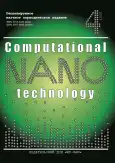Алгоритмы управления двигателями антропоморфного захвата с групповым приводом
- Авторы: Жданова Ю.И.1, Мошкин В.В.1, Романов М.П.1
-
Учреждения:
- МИРЭА – Российский технологический университет
- Выпуск: Том 10, № 4 (2023)
- Страницы: 72-83
- Раздел: АВТОМАТИЗАЦИЯ И УПРАВЛЕНИЕ ТЕХНОЛОГИЧЕСКИМИ ПРОЦЕССАМИ И ПРОИЗВОДСТВАМИ
- URL: https://journals.rcsi.science/2313-223X/article/view/251953
- DOI: https://doi.org/10.33693/2313-223X-2023-10-4-72-83
- ID: 251953
Цитировать
Аннотация
Постановка задачи: современной тенденцией является использование в различных сферах деятельности человека сервисных роботов, оснащенных антропоморфными захватами (АЗ) обладающим возможностями присущими кисти руки человека. Функциональные возможности АЗ определяются исполнительными группами звеньев (ИГЗ) имеющими групповой привод с переменной структурой. При обхвате внешнего объекта (ВО) каждая оппозитная ИГЗ последовательно реализует контакт тремя выходными звеньями. Алгоритм одновременного управления двигателями должен обеспечить неизменное положение незакрепленного ВО. Известные способы управления АЗ, например, импедансное, не обеспечивают данное требование. Кроме того, возможные способы ориентированы на неизменный объект управления, в качестве которого выступает одно выходное звено ИГЗ. Целью работы является разработка алгоритмов позволяющих, в отсутствии исходной информации о ВО, обеспечить идентификацию его положения на опоре и осуществить обхват несколькими выходными звеньями. Используемые методы: теоретические исследования опираются на основные положения анализа функционирования сложных систем, обработки информации, определяющей их состояние и принятие решений на их основе. Новизна предложенных алгоритмов заключается в том, управление двигателем основывается на информации о взаимодействии выходных звеньев как данной ИГЗ, так и оппозитной. Последовательность включения двигателей определяется на основе анализа изменения совокупности условий. Внешних – контакт текущего объекта управления с ВО, внутренних – увеличение момента на двигателе по сравнению с величиной, определяющей свободное движение. Такой подход позволяет при наличии только датчиков контакта на выходных звеньях реализовать адаптивное управление двигателями оппозитных ИГЗ. Результат: использование предложенных алгоритмов позволяет формализовать управление двигателями оппозитных ИГЗ с учетом положения изначально не детерминированного ВО. Практическая значимость: разработанные алгоритмы предназначены для управления антропоморфными захватами, выполняющими действия с ВО в неблагоприятных для человека условиях и неопределенности положения ВО. Их использование позволит повысить функциональность роботов, оснащенных АЗ.
Полный текст
Открыть статью на сайте журналаОб авторах
Юлия Ильдаровна Жданова
МИРЭА – Российский технологический университет
Автор, ответственный за переписку.
Email: zhdanova_yu@mirea.ru
ORCID iD: 0000-0002-3161-2646
старший преподаватель, кафедра системной инженерии, заместитель директора Института искусственного интеллекта
Россия, МоскваВладимир Валентинович Мошкин
МИРЭА – Российский технологический университет
Email: mvv56@inbox.ru
ORCID iD: 0000-0002-5421-5029
кандидат технических наук, доцент, кафедра системной инженерии
Россия, МоскваМихаил Петрович Романов
МИРЭА – Российский технологический университет
Email: m_romanov@mirea.ru
ORCID iD: 0000-0003-3353-9945
доктор технических наук, профессор, кафедра проблем управления, директор Института искусственного интеллекта
Россия, МоскваСписок литературы
- Bogdanov А.А., Permyakov А.F., Zhdanova Yu.I. Synthesis of structural scheme of drive of adaptive multiple-link gripper // Zavalishin’s Readings. MATEC Web of Conferences. 2018. Vol. 161. Art. no. 03009. DOI: https://10.1051/matecconf/2018161030093.
- Billard A., Kragic D. Trends and challenges in robot manipulation // Science. 2019. Vol. 364. No. 6446.
- Жданова Ю.И. Алгоритм адаптивного управления оппозитными исполнительными системами с переменной структурой // Современная наука: актуальные проблемы теории и практики. Серия: Естественные и технические науки. 2021. № 2. С. 51–57.
- Zhdanova Yu.I., Moshkin V.V. Method of optimization synthesis of parameters of actuating system of anthropomorphic gripper with adaptive control // IOP Conference Series: Materials Science and Engineering. 2020. Vol. 971. No. 4. P. 042065.
- You W.S. et al. Design of a 3D-printable, robust anthropomorphic robot hand including intermetacarpal joints // Intelligent Service Robotics. 2019. Vol. 12. No. 1. Pp. 1–16.
- Golan Y., Shapiro A., Rimon E.D. A variable-structure robot hand that uses the environment to achieve general purpose grasps // IEEE Robotics and Automation Letters. 2020. Vol. 5. No. 3. Pp. 4804–4811.
- Kang L. et al. Design and Implementation of a Multi-Function Gripper for Grasping General Objects // Applied Sciences. 2019. Vol. 9. No. 24. P. 5266.
- Chu Z.Y. et al. Impedance identification using tactile sensing and its adaptation for an underactuated gripper manipulation // International Journal of Control, Automation and Systems. 2018. Vol. 16. No. 2. Pp. 868–875.
- Wang C. et al. Feature sensing and robotic grasping of objects with uncertain information: A review // Sensors. 2020. Vol. 20. No. 13. P. 3707.
- Kashef S.R., Amini S., Akbarzadeh A. Robotic hand: A review on linkage-driven finger mechanisms of prosthetic hands and evaluation of the performance criteria // Mechanism and Machine Theory. 2020. Vol. 145. P. 103677.
- Пермяков А.Ф., Богданов А.А., Жданова Ю.И. Адаптивный привод группы звеньев захвата. Патент РФ № 185794. 2018. Бюл. № 35.
- Huynh B.P., Kuo Y.L. Optimal fuzzy impedance control for a robot gripper using gradient descent iterative learning control in fuzzy rule base design // Applied Sciences. 2020. Vol. 10. No. 11. P. 3821.
- Raiola G. et al. Development of a safety-and energy-aware impedance controller for collaborative robots // IEEE Robotics and Automation Letters. 2018. Vol. 3. No. 2. Pp. 1237–1244.
- Park J., Choi Y. Input-to-state stability of variable impedance control for robotic manipulator // Applied Sciences. 2020. Vol. 10. No. 4. P. 1271.
- Erdemir G. Force transmission analysis of surface coating materials for multi-fingered robotic grippers // Peer J. Computer Science. 2021. Vol. 7. P. e401.
- Neha E. et al. Grasp analysis of a four-fingered robotic hand based on Matlab simmechanics // Journal of Computational & Applied Research in Mechanical Engineering (JCARME). 2020. Vol. 9. No. 2. Pp. 169–182.
- Салагор А.Ю., Степанов И.В. Современные роботизированные комплексы разминирования: зарубежные и отечественные разработки // Актуальные вопросы совершенствования тактико-специальной, огневой и профессионально-прикладной физической подготовки в современном контексте практического обучения сотрудников органов внутренних дел: сборник трудов междунар. науч.-практ. конф. СПб.: Изд-во С.-Петербургского ун-та Министерства внутренних дел РФ, 2019. С. 341–344.
- Huynh B.P., Kuo Y.L. Optimal fuzzy impedance control for a robot gripper using gradient descent iterative learning control in fuzzy rule base design // Applied Sciences. 2020. Vol. 10. No. 11. P. 3821.
- Li M. et al. Fuzzy impedance control of an electro-hydraulic actuator with an extended disturbance observer // Frontiers of Information Technology & Electronic Engineering. 2019. Vol. 20. No. 9. Pp. 1221–1233.
Дополнительные файлы













